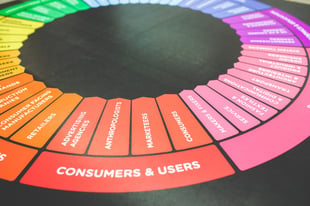How often does your organization use its buyer personas to make decisions?
I’m asking because buyer personas have always bothered me a bit. In my experience, marketing teams agonize over these personas. We brainstorm alliterative names, select stock photography headshots that best capture the demographics of the fictional person we’re developing, and put together a list of their attributes that will help us as marketers create the best experiences for our target audiences.
As much as I love being “Insightful Ilene,” my frustration with personas is three-fold:
However, our sales teams know customers best the further they get into the buying process. Basing our personas on that data doesn’t help marketers understand how prospects initially look for solutions to their challenges. Similarly, our product teams tend to interact at a “user” level—they’re looking to see how someone will interact with the product or service in question. They’re not concerned with the emotional elements surrounding a purchase, or what a customer’s needs are.
2) Brands tend to fill in persona gaps with their own assumptions. This is a situation I understand well. If you’ve been in a particular industry or worked at the same company for several years, you might feel like you know your customers pretty intimately. What might have been true—or easily assumed—about our customers is not the reality today. We sometimes forget that their world is always shifting, which means we need to shift, too.
3) Personas are designed to work at a high level. We might not dig into obtaining the intel that would really help our teams—understanding our persona’s needs at every stage of the buying cycle, for example. In an effort to keep personas simple to digest for those that need them, we often generalize.
If personas, as we know them, aren’t helping us create the messaging and experiences our customers and prospects deserve, what do we need to do differently? I maintain instead of being overly concerned with who they are, we’ll be in a much better position if we focus on what they need and why they need it.
One Persona = Many Pain Points
Thinking about personas through the lens of pain points isn’t a new practice. What might be a new practice is to segment your personas based on the specifics of their pain points.
For example, let’s say you’re a performance marketing agency, and your main persona is based on the CMO of an e-commerce company. That persona could have several different pain points, including these two:
My frustration with personas is three-fold.
- Lack of bandwidth. The CMO wants to have performance marketing in their marketing mix, but it’s a set of technical skills no one on the marketing team has. They’re looking to outsource to an agency with the skills and the bandwidth to set up a program.
- Looking for growth. A company might be a small player in their industry, and the CMO wants to change that. They’re laser-focused on growth, and they know performance marketing can play a significant role.
Your agency can solve both of these pain points but will need distinctly different messaging and content to appeal to both challenges. Flipping the script to concentrate on pain points gives us the opportunity to find that sweet spot of relevancy rather than being overly broad.
Why Don’t We Know Our Customers?
Here’s a question I was recently asked: If it’s marketing’s job to know our customers inside and out… why don’t we?
It’s not because marketers don’t want to know. In fact, we know that knowing our customers intimately would make our goals of creating and delivering value a whole lot easier. Like everything, however, that knowledge takes time. We’re always moving fast. Getting a few bullet points of information from the sales team might mean less time than silently sitting on sales calls to hear objections and challenges from a prospect in their own words. Pouring over behavioral marketing data and identifying patterns is an enormous undertaking compared to gleaning a few insights from your quarterly assessments.
There are also cost limitations. Focus groups and concept testing that was once the hallmark of big marketing agencies and brands is pricey—both the set-up and the travel.
It’s not because marketers don’t want to know.
Still, there are plenty of other ways to get to know our customers. A long time ago, a friend of mine moved to Tennessee and started working for FedEx. As a senior manager, part of her onboarding was to immerse herself in every part of the business for a dedicated period of time. She sat shotgun in a FedEx truck, packaged goods, performed data entry, and listened in on customer support calls, all in service of truly understanding all sides of the customer experience.
SMBs may not have this kind of flexibility, but there are other opportunities for cross-pollination. Can your organization create a rotational program for your marketing team where they sit in a specific department a day each month to understand all of the entry points for a customer with your brand? Can a junior member of your marketing team be the designated “Insights Collector” and spend a week doing nothing but listening in on sales calls? Can you design a survey strategy that makes it possible to constantly be collecting feedback from customers and prospects?
Yes, these ideas still take time—and a bit of money. Yet, in doing so, you’ll be able to focus your marketing efforts and zero in on what you know your customers need instead of assuming.
Prioritizing Reason (and Action) Over Demographics
Personas are a critical part of your marketing efforts. The key is to curate a persona by combining the facts with the emotional catalysts, challenges, and behaviors that lead to a potential purchase.
That, in turn, can help you determine how—and where—to show up. Both for the customers that need you, and the customers who don’t know. At least, not yet.
See our YouTube channel, Marketing Air-Cover, for additional guidance on marketing strategy for small businesses.
Learn more about hiring a fractional CMO here.








